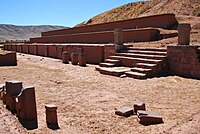Guaruma Empire: Difference between revisions
Mr.Trumpet (talk | contribs) No edit summary |
Mr.Trumpet (talk | contribs) No edit summary |
||
| Line 35: | Line 35: | ||
==Geography== | ==Geography== | ||
The Guaruma civilization originated north of the present-day city of Sol Marina, near the archaeological site of Guaruma. Its maximum extent is poorly known, but archaeological research indicates expansion over vast territories towards the north, reaching as far as Lake Chakumiri. | The Guaruma civilization originated north of the present-day city of Sol Marina, near the archaeological site of Guaruma. Its maximum extent is poorly known, but archaeological research indicates expansion over vast territories towards the north, reaching as far as [[Lake Chakumiri]]. | ||
==History== | ==History== | ||
Latest revision as of 18:28, 19 March 2024
This article is incomplete because it is pending further input from participants, or it is a work-in-progress by one author. Please comment on this article's talk page to share your input, comments and questions. Note: To contribute to this article, you may need to seek help from the author(s) of this page. |
Guaruma Empire | |
|---|---|
| 400 - 1000 | |
 Ruins of Guaruma | |
| Capital | Guaruma |
| Common languages | Guaruma |
| Demonym(s) | Guaruman |
| Government | Divine, absolute monarchy |
| Today part of | |
The Guaruma Empire is a pre-Tuachec civilization that dominated the eastern region of present-day Pecario between the 5th and 11th centuries.
Geography
The Guaruma civilization originated north of the present-day city of Sol Marina, near the archaeological site of Guaruma. Its maximum extent is poorly known, but archaeological research indicates expansion over vast territories towards the north, reaching as far as Lake Chakumiri.
History
Guaruma began its steady growth in the early centuries of the first millennium AD. nitially, Guaruma was a modest agricultural village. However, from approximately 375 to 700 AD, it burgeoned into a bustling urban center and emerged as a formidable regional power. During its zenith, Guaruma boasted a population exceeding 10,000 inhabitants, indicative of its prosperity and influence.
By approximately 1000 AD, the Guaruma Empire experienced a decline, with the city eventually fading into obscurity. The precise reasons for this collapse remain subjects of scholarly debate, with theories ranging from environmental factors to socio-political upheavals.
Art
Guarumian monumental architecture is characterized by large stones of exceptional workmanship. Guaruman stone architecture typically employs rectangular ashlar blocks laid in regular courses. Guaruma sculpture typically consists of blocky, column-like figures with large, flat square eyes, detailed with shallow relief carving. Guarumans also practiced the art of Petroglyph. Most depicted scenes are symbols representing wild animals, llamas, and deities.
